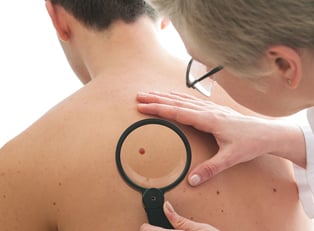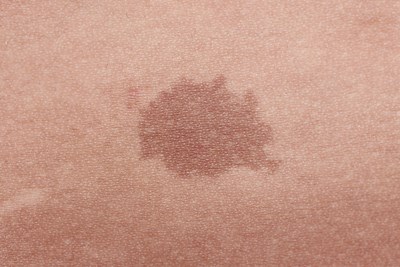Birthmarks are marks that appear on the skin -- often at birth, though sometimes not until later. Almost everyone has some form of birthmark, but they appear in different places and it is exceedingly rare to find two that look the same. Birthmarks differ not just in shape, but in the specific type of birthmark. Here’s a look at common types of birthmarks.
Cafe au Lait
French for “coffee with milk,” this birthmark can look like a spill of creamed coffee across the skin and is named for its coloring. Cafe au lait spots are brown in color, but range in shade from light tan to a dark chocolate. They also range in size, and may even grow larger as the person grows older. Presumably, the growth of the skin extends the area affected by alternately-pigmented skin cells. Cafe au lait spots are quite common and one person may even have multiple spots on their body. Although they are normally harmless, six or more spots may be indicative of genetic diseases such as neurofibromatosis and merit a medical examination.
Congenital Nevus
A congenital nevus (plural: nevi) is a dark brown spot, similar to a mole. They do not usually have the characteristic roundness moles tend toward, may be raised or flat, and may have extra or abnormal hair growth. Congenital nevi range in size from the width of the tip of a finger to a few inches. The scalp and the front or back of the abdomen are the most common places for congenital nevi to occur. While they are not necessarily worrisome in and of themselves, this type of nevus can be suggestive of a predisposition to develop skin cancers, particularly melanoma. If you have a congenital nevus, take extra precautions when outdoors and check periodically for strange or changing spots on the skin.
Moles
Moles tend to appear as you age, but they can also be present at birth -- in which case they are more often called “beauty marks” particularly when on the face. Moles vary widely in color and size, but generally appear as a round, raised spot (although some are considerably flatter while some are considerably higher). They may be as small as a freckle or closer in size to the wrong end of a pen. Moles may be pink, dark brown, or barely distinguishable from a flesh-tone. More may appear as you grow older. Similarly to nevi, moles can be an indicator of cancer; if you notice a change in the appearance of moles -- particularly those that are newly developed -- talk to your doctor immediately.
Port-Wine Stain
Port-wine stains are a vascular birthmark, which means that they develop as a result of blood vessels, rather than skin pigmentation. Port wine stains appear more commonly on the face or neck, but may be anywhere on the body from birth. Additionally, these birthmarks are red in color, but may be very light or a dark purplish-red. Affecting only about 10% of the population, port wine stains can interfere with signals between the eyes and the brain or co-occur with conditions like Klippel-Trenaunay syndrome -- and tend to become more obvious with time.
Stork Bites and Angel Kisses
Also called angel kisses, stork bites are also vascular birthmarks. Caused by capillaries that form close to the top of the skin, they are generally reddish in appearance. Rather than a propensity to cover a large area, angel kisses are generally about the size of a quarter. They do, however, also appear on the head and neck -- exactly where they form tends to impact what they’re called (one on the forehead would be an angel kiss, while one on the back of the neck would be a stork bite). Angel kisses tend to fade considerably over time and do not usually herald any medical concerns.
Slate Grey Nevus (Mongolian Spot)
Slate grey nevi are nevi named for their coloring -- a deep grey color, that may be mistaken for bruising. Also called mongolian spots, these birthmarks tend to fade. Additionally, they are more common on darker shades of skin, particularly those of black or Asian descent. A slate grey nevus merits no medical concern, but can be quite large.
Strawberry Hemangioma
Hemangiomas are also vascular birthmarks, and so appear in shades of blood -- purple, red, or pink. Hemangiomas may grow larger during infancy and toddlerhood, rising a few centimeters from the skin, but they generally disappear to little more than a discoloration within the first decade of life. Depending upon their placement, they may be problematic. For example, a hemangioma near the eye may inhibit vision, while one near the mouth may disrupt feeding the baby. It is possible for them to become an open wound. If you’re worried about your child’s birthmark, talk to his pediatrician about your options.



